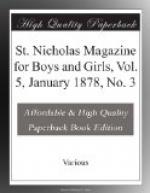This little story may be a fable; but now I shall tell you some facts. When the Romans came to Britain to live, many hundred years ago, they brought, of course, their own customs and festivals, among which was this one in memory of Flora. The heathen—our ancestors, you know—adopted them with delight, being in the childhood of their race. They became very popular; and when, some years later, a good priest, Gregory, came (from Rome also) to convert the natives, he wisely took advantage of their fondness for festivals, and not trying to suppress them, he simply altered them from heathen feasts to Christian games, by substituting the names of saints and martyrs for heathen gods and goddesses. Thus the Floralia became May-day celebration, and lost none of its popularity by the change. On the contrary, it was carried on all over England for ages, till its origin would have been lost but for a few pains-taking old writers, who “made notes” of everything.
The Floralia we care nothing for, but the May-day games have lasted nearly to our day, and some relics of it still survive in our young country. When you crown a May queen, or go with a May party, you are simply following a custom that the Romans began, and that our remote ancestors in England carried to such lengths, that not only ordinary people, but lords and ladies, and even king and queen, laid aside their state and went “a-Maying” early in the morning, to wash their faces in May dew, and bring home fresh boughs and flowers to deck the May-pole, which reared its flowery crown in every village.
Great were the doings around the May-pole, for which the tallest and straightest of trees was selected. It was drawn to its place by as many as thirty or forty yoke of oxen, their horns decorated with flowers, followed by all the lads and lassies of the village. The pole was wound or painted with gay colors, and trimmed with garlands, bright handkerchiefs, and ribbon streamers, from top to bottom.
With great ceremonies, and shouts of joy, it was lifted to its place by ropes and pulleys, and set up firmly in the ground; and then the people joined hands and danced around it. The whole day was given up to merriment, every one dressed in holiday clothes, doors and windows were adorned with green boughs and flowers, the bells rang, processions of people in grotesque dresses were arranged, and the famous Morris dancers performed.
In this dance the people assumed certain characters. There was always Robin Hood, the great hero of the rustics; Maid Marian, the queen, with gilt crown on her head; Friar Tuck; a fool, with his fool’s-cap and bells; and, above all, the hobby-horse. This animal was made of pasteboard, painted a sort of pink color, and propelled by a man inside, who made him perform various tricks not common to horses, such as threading a needle and holding a ladle in his mouth for pennies.
The various characters labored to support their parts. The friar gave solemn advice, the queen imitated lady-like manners, the fool joked and made fun, and the horse pranced in true horsey style.




